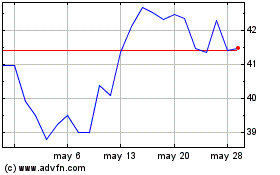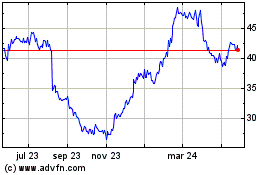Owner of Coach Brand Fashions an IT Makeover
24 Octubre 2019 - 9:29AM
Noticias Dow Jones
By Agam Shah
Luxury-goods company Tapestry Inc., the owner of the Coach and
Kate Spade brands, has undergone a tech makeover aimed at cutting
costs and improving the shopping experience.
Acquiring Kate Spade in 2017 for $2.4 billion and Stuart
Weitzman in 2015 for $574 million left the company, formerly called
Coach, with three brands operating independently under one roof.
Various employees were doing similar tasks using different
processes and information-technology systems.
Michael Braine, the company's chief information officer, is
putting the finishing touches on an overhaul that has reduced
duplication and centralized business operations across the three
brands. The CIO in August wrapped up the latest phase to establish
a common technological backbone for functions including inventory
management, distribution and sales.
"The real value of what we've done is take out excess system
costs, excess people costs across three brands," said Mr. Braine,
who manages a combined IT staff of about 400. The company now has
about 550 software applications, down from a peak of nearly
800.
New York-based Tapestry operates about 1,500 stores under its
three brands and employs roughly 20,000 people world-wide. It also
sells its handbags, shoes and apparel in department stores.
Last month, the company ousted Victor Luis, who had been chief
executive for five years, after struggles with the Kate Spade brand
prompted it to lower earnings guidance for the year. Mr. Luis was
succeeded by Chairman Jide Zeitlin, who has been on the board since
2006.
The centerpiece of the IT overhaul is a new software platform
built around SAP SE's S/4HANA enterprise-resource planning software
that bridges back-office, logistics and other systems. ERP software
integrates various functions into one system, streamlining
processes and data across the company.
Different functions were integrated in phases. "In the past the
[systems] were integrated into seven ERP systems across brands and
geographies and now we have one, single, global, multibrand
platform," Mr. Braine said.
That provides a foundation for real-time features including
inventory checks, in-store pickup for online purchases or the
ability for sales associates to reserve a product for customers.
Some shopping features are already available, while others will be
implemented later, Mr. Braine said.
"All of these types of things that people want to do rely on the
real-time accuracy of customer and inventory and sales data," Mr.
Braine said.
A spokeswoman said Tapestry will start seeing benefits from the
ERP system in the fiscal year ending in June 2020, but declined to
say how much the company expects to save. The company took a charge
of $36.9 million related to ERP implementations in fiscal 2019 and
expects a charge of about $30 million to $40 million for the
current financial year.
ERP systems are long-term investments that don't necessarily pay
for themselves right off the bat, said Paul Schenck, a senior
principal analyst at research and advisory firm Gartner Inc. "Seven
years to eight years is often the break-even where you will see all
of the investment that it took to get the system live start to pay
off," he said.
Tapestry's ERP system takes information from point-of-sales
systems in stores into a common back-office operation so there is a
single process on functions such as reporting and auditing as well
as calculating margins and taxes due.
The company now has a common system to collect and merge data
generated by operations including inventory management and sales,
providing a better high-level view of business performance across
brands.
"From a customer or [sales] associate perspective, it's the same
point-of-sales that they've historically had, but on the
back-office perspective, everything is transformed so that it is a
common process," Mr. Braine said.
Gartner's Mr. Schenck said a phased approach helps Tapestry
avoid costly mistakes and reduce complexities. That is different
from a previous approach that companies used to take, where entire
ERP systems were delivered in one go, he added.
Write to Agam Shah at agam.shah@wsj.com
(END) Dow Jones Newswires
October 24, 2019 10:14 ET (14:14 GMT)
Copyright (c) 2019 Dow Jones & Company, Inc.
Tapestry (NYSE:TPR)
Gráfica de Acción Histórica
De Jun 2024 a Jul 2024

Tapestry (NYSE:TPR)
Gráfica de Acción Histórica
De Jul 2023 a Jul 2024
